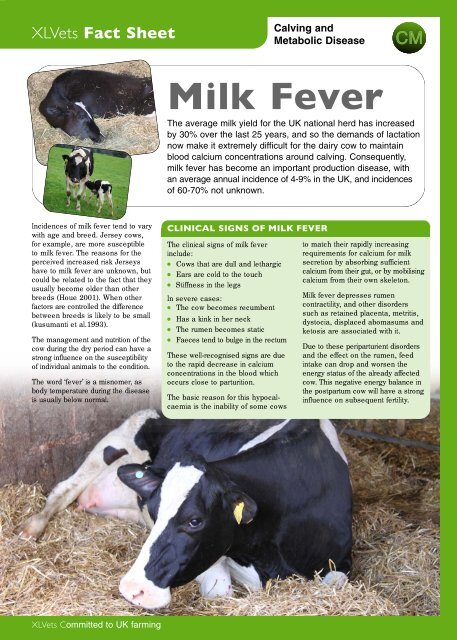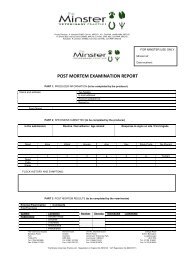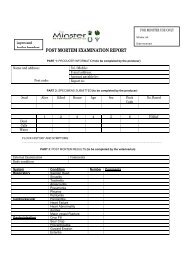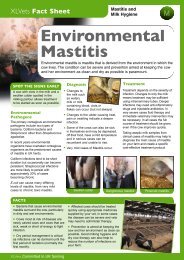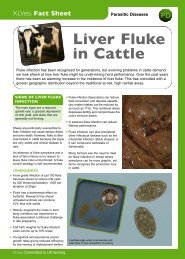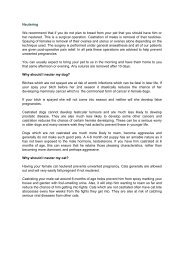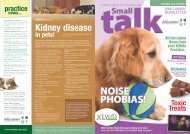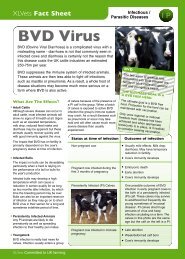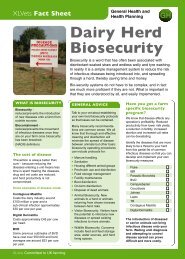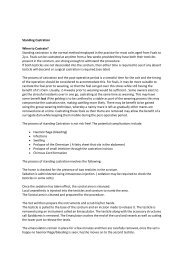Milk Fever (PDF) - Minster Vets
Milk Fever (PDF) - Minster Vets
Milk Fever (PDF) - Minster Vets
Create successful ePaper yourself
Turn your PDF publications into a flip-book with our unique Google optimized e-Paper software.
XL<strong>Vets</strong> Fact Sheet<br />
Calving and<br />
Metabolic Disease<br />
CM<br />
<strong>Milk</strong> <strong>Fever</strong><br />
The average milk yield for the UK national herd has increased<br />
by 30% over the last 25 years, and so the demands of lactation<br />
now make it extremely difficult for the dairy cow to maintain<br />
blood calcium concentrations around calving. Consequently,<br />
milk fever has become an important production disease, with<br />
an average annual incidence of 4-9% in the UK, and incidences<br />
of 60-70% not unknown.<br />
Incidences of milk fever tend to vary<br />
with age and breed. Jersey cows,<br />
for example, are more susceptible<br />
to milk fever. The reasons for the<br />
perceived increased risk Jerseys<br />
have to milk fever are unknown, but<br />
could be related to the fact that they<br />
usually become older than other<br />
breeds (Houe 2001). When other<br />
factors are controlled the difference<br />
between breeds is likely to be small<br />
(kusumanti et al.1993).<br />
The management and nutrition of the<br />
cow during the dry period can have a<br />
strong influence on the susceptibility<br />
of individual animals to the condition.<br />
The word ‘fever’ is a misnomer, as<br />
body temperature during the disease<br />
is usually below normal.<br />
CLINICAL SIGNS OF MILK FEVER<br />
The clinical signs of milk fever<br />
include:<br />
● Cows that are dull and lethargic<br />
● Ears are cold to the touch<br />
● Stiffness in the legs<br />
In severe cases:<br />
● The cow becomes recumbent<br />
● Has a kink in her neck<br />
● The rumen becomes static<br />
● Faeces tend to bulge in the rectum<br />
These well-recognised signs are due<br />
to the rapid decrease in calcium<br />
concentrations in the blood which<br />
occurs close to parturition.<br />
The basic reason for this hypocalcaemia<br />
is the inability of some cows<br />
to match their rapidly increasing<br />
requirements for calcium for milk<br />
secretion by absorbing sufficient<br />
calcium from their gut, or by mobilising<br />
calcium from their own skeleton.<br />
<strong>Milk</strong> fever depresses rumen<br />
contractility, and other disorders<br />
such as retained placenta, metritis,<br />
dystocia, displaced abomasums and<br />
ketosis are associated with it.<br />
Due to these periparturient disorders<br />
and the effect on the rumen, feed<br />
intake can drop and worsen the<br />
energy status of the already affected<br />
cow. This negative energy balance in<br />
the postpartum cow will have a strong<br />
influence on subsequent fertility.<br />
XL<strong>Vets</strong> Committed to UK farming
XL<strong>Vets</strong> <strong>Milk</strong> <strong>Fever</strong><br />
Calving and<br />
Metabolic Disease<br />
CM<br />
PREVENTION OF MILK FEVER<br />
Conventional methods for the prevention of milk fever include:<br />
Method 1:<br />
Restriction of calcium in the<br />
prepartum period.<br />
This activates the calcium homeostatic<br />
mechanisms. This method is effective<br />
only if sufficiently low dietary calcium<br />
levels are fed (20g/day). However due<br />
to the fixed calcium concentrations of<br />
forages fed in the prepartum diet,<br />
manipulation of the diet to low enough<br />
calcium levels is not possible.<br />
Both zeolite and vegetable oils have<br />
been shown to reduce the absorption<br />
of Ca sufficiently (Wilson, 2003).<br />
However they may not be suitable<br />
for other reasons (amount required,<br />
effects on rumen microbes<br />
(Goff 2008)).<br />
Method 2:<br />
Magnesium supplementation at<br />
15 to 20g/day.<br />
This needs to be given with a<br />
source of easily digestible<br />
carbohydrates<br />
to encourage<br />
uptake.<br />
Method 3:<br />
Peripartum supplementation<br />
of susceptible animals with<br />
injectable or oral calcium.<br />
This is labour-intensive, time<br />
consuming and may even have<br />
negative effects as a large depot of<br />
calcium can switch off homeostatic<br />
pathways. This should not be used<br />
as a first line prevention.<br />
THE DIETARY CATION-ANION BALANCE<br />
It has been shown that prepartum<br />
dietary cation-anion balance (DCAB)<br />
is strongly correlated to the clinical<br />
incidence of milk fever.<br />
Reducing DCAB rather than the<br />
calcium content of the prepartum<br />
ration is now considered the method<br />
of choice for preventing milk fever.<br />
What is DCAB?<br />
DCAB is defined as:<br />
DCAB (mEq/Kg DM) = (sodium +<br />
potassium) + (chlorine + sulphur).<br />
The DCAB ration can be easily<br />
calculated if the percentage<br />
concentrations (in Dry Matter terms)<br />
of sodium, potassium, chlorine and<br />
sulphur ions are known.<br />
A negative DCAB ration causes mild<br />
metabolic acidosis, which increases<br />
the production of Vitamin D3. This has<br />
an effect through a series of hormones<br />
and pathways to cause an increased<br />
mobilisation of calcium from the bone<br />
and uptake from the intestines.<br />
Due to the induced metabolic<br />
acidosis, and a conservation<br />
of bicarbonate ions, the<br />
urine becomes more acidic,<br />
making urine pH monitoring a<br />
useful tool for assessing the effect of<br />
reducing DCAB.<br />
DCAB Rationing<br />
For a DCAB ration to be successful, close<br />
work with your vet and nutritionist is essential.<br />
●<br />
●<br />
●<br />
●<br />
Grass silage analysis must be carried out.<br />
Urine pH monitoring has to be done on a<br />
regular basis and a sufficient period of time<br />
on the diet must occur, at least 3 weeks<br />
before calving.<br />
If cows are at grass during the dry period,<br />
then housing them 3 weeks prior to calving is<br />
preferable.<br />
If it is not possible to house 3 weeks prior to<br />
calving, then move them to a field which has<br />
not received potash and has sparse growth<br />
so as to encourage the buffer feed to be<br />
eaten.<br />
For further information contact your local XL<strong>Vets</strong> practice:<br />
XL<strong>Vets</strong> Committed to UK farming. Go to XL<strong>Vets</strong> www.xlvets.co.uk<br />
Committed to UK farming. Go to www.xlvets.co.uk


